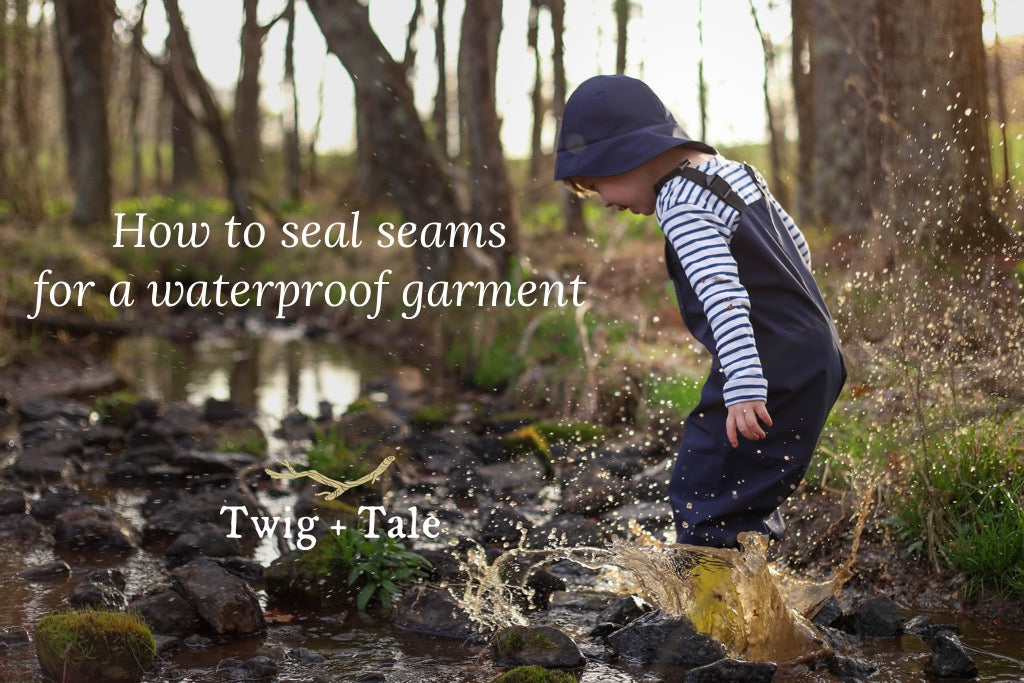In order to make outerwear truly waterproof, one way to seal up the seams is using specialized seam-sealing tape. Alternatively, if using a natural fabric you could wax the seams as shown here.
Here are instructions for sealing flat seams (such as the Rainhaven Pants and Overalls), as well as curved seams (such as the Sou'wester Rain Hat).
With fully-sealed outdoor gear, you and your family will be ready for splashy rainy day adventure!

Outerwear fabric may be waterproof, but seams and needle holes can still allow water seep through. This can be remedied by applying seam-sealing tape, a waterproof adhesive film. The process is quite simple, and though it adds a bit of extra time to a sewing project, the results are worth it: functional, waterproof outdoor gear, made by you!
Materials

- Scissors
- Seam-sealing tape
- Baking/parchment paper
- Iron
Note that we will cover the seam-sealing tape with baking/parchment paper when ironing, so that it doesn't adhere to the baseplate of the iron.
Sealing a flat seam
These instructions demonstrate how to seal a straight, flat seam, such as those in the Twig + Tale Rainhaven Pants and Overalls. Instructions for sealing a curved seam follow.
1. Construct seam as directed in tutorial. There should be one row of stitching visible on the right side and two rows on the wrong side.

2. Trim off half the seam allowance.

3. Working on your ironing surface, lay the seam sealing tape over the seam on the wrong side of the garment. Ensure that the entire seam allowance, as well as the rows of stitching, are covered by the seam-sealing tape.

4. Adjust the iron temperature to the lowest setting. Cover the tape with baking paper.
It is sometimes difficult to tell which is the sticky side of the tape, so test a small patch at one end.

5. If the tape sticks to the paper, the tape is the wrong side up. Peel it off and turn it over.
TIP - After you have turned the tape over, you can use the sticky test patch to affix the tape to the fabric.

7. Press the seam sealing tape through the paper.

8. The tape will become more transparent as it seals. Keep pressing until it is fully sealed. If there are any patches that have bubbles or unsealed sections, go over them again until the whole seam is sealed.
This photo shows the left part sealed and the right part unsealed.

9. Trim off the excess tape. Voila, a sealed seam!

You can watch a video on sealing flat seams here:
Sealing a curved seam
The tape works in the same way, however the technique for getting the tape to lie flat along a curved seam is a bit different. Here, we demonstrate the technique for applying tape to curved seams, such as those in the Sou'Wester Rain Hat.
Materials

- The materials are the same as above, with the suggested addition of a Tailor's Ham. It is optional, but makes the job much simpler, and we have a free pattern for making a Tailor's Ham.
1. As above, construct seam as directed in tutorial. There should be one row of stitching visible on the right side and two rows on the wrong side, with seam allowances trimmed back.

2. Using the curve of a pressing ham or the edge of your ironing board, position the seam so that it is flat.

3. Lay the seam-sealing tape over the seam on the wrong side of the garment. Ensuring that the tape is flat, and that it covers the seam allowance and stitch lines.

4. With iron temperature at lowest setting, press through the paper to test one end of the tape to ensure it is sticky side down, as explained above. If necessary, flip tape over so sticky side is towards the fabric.

5. Press the seam-sealing tape through the paper. It is fine to do a little bit at a time to ensure the tape stays flat around the curve. Ensure there are no bubbles or wrinkles and the seam is fully sealed.

6. Trim off the excess tape.

You can watch a video on sealing curved seams here:

That's it, you've created your very own waterproof garment! We hope that these instructions are of use to you, and show you that sewing your own waterproof outerwear is not as difficult as it may seem.
Please feel free to join us in the Twig + Tale Chat Facebook group to share your projects, ask questions, or look for inspiration.
~ Cover image by Jordyn Shelor ~





